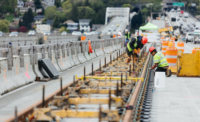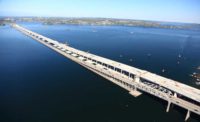For more than a decade, the construction world has kept an eye on efforts to build a new State Route 520 floating bridge—the world’s longest—which connects Seattle to points east on Lake Washington. But after its grand opening in April, attention on the shiny new bridge with a roadway elevated 20 ft above the floating pontoons has faded. Now crews have turned their attention to removing the old bridge.
Located mere feet to the south of the new bridge, the 7,580-ft-long concrete pontoon bridge may no longer have a purpose in Seattle, but the pontoons will live on in projects worldwide. Dismantling the bridge has become a priority as part of the larger $2.38-billion bridge project expected to wrap up before this winter, with a tricky detensioning job a critical part of the process.
“Once we opened the new bridge, we immediately started the decommissioning process to remove the old bridge from the lake,” says Dave Becher, Washington State Dept. of Transportation director of construction for the bridge replacement and HOV program. “The [old] bridge is a vulnerable structure, and it puts the new bridge at risk. It is very critical for us to get the old bridge removed before the storm season at the end of the year so we don’t have to worry about it being damaged or damaging the new bridge.”
But pulling apart 31 pontoons for resale and repurposing poses a challenge because of external post-tensioning that runs the length of the bridge.
Joint venture Kiewit-General-Manson, working with Northstar Demolition for the removal of the approaches and road decks, called on Schwager Davis Inc. to devise a way to deal with that post-tensioning dilemma.
“It is a mixed bag of bonded and unbonded post tensioning,” says Jacob Myer, design engineer for SDI. “It is really unique that you would be detensioning that and that these spans are the longest in the world.” The two styles of post-tensioning incorporates both independent free movement of strands in some places and not in others.
With 24 ft of stored energy in the tendons, Myer says the challenge was devising a way to release the energy without setting off a chain reaction with the worst-case outcome: sinking pontoons.
“State Route 520’s floating bridge decommissioning is the most complicated post-tensioning challenge of my career,” says Guido Schwager, president of SDI.
Beginning To End
The challenge started in 1963 when the Evergreen Point Floating Bridge opened for traffic at more than 7,500 ft in length. But it really grew in 1997 when a seismic retrofit increased the design capacity to handle sustained winds of 77 mph instead of 57 mph by giving the bridge 32 new, external high density polyethylene resin-duct encased, grout-bonded tendons running through the pontoons. A typical tendon length may run roughly 400 ft, but 16 of the tendons on the State Route 520 bridge ran 3,200 ft and 16 more went 3,600 ft, adding 500 psi of axial compression to keep the bridge’s concrete pontoons together.
When it came time to pull the old bridge apart, confronting the grouted and external tendons posed the trickiest of challenges. Having them be both grouted and external meant cutting or mechanically releasing one strand simply transferred the load into the bonded whole, yet with one fewer strand holding. Once four strands were cut, the remaining strands would eventually fail and release up to 615,000 lb of force and retract the remaining tendon length “like a lethal rubber band,” SDI says.
“It is really unique that you would be detensioning bonded and unbonded,” Myer says. “And with the lengths of these spans being (among) the longest in the world, you have 24 ft of stored energy in these tendons, which is a tremendous amount.”
To find a solution, Kiewit-General-Manson analyzed several scenarios. One idea involved using robots to cut the tendons to remove the danger to humans. Another idea included removing the HDPE pipe from a section of the tendon within a hollow pontoon, clamping over each end of the section with high-tension bars and taking the force of the small section between the clamps.
SDI determined there were problems with both proposals. The robot scenario would likely create such a whipping force in the cut tendons that it would break through pontoon walls and sink both concrete and robot. The second plan seemed more realistic, but there were still significant issues. Not knowing the condition and strength of the existing grout and relying solely on friction between a clamp device offered the chance for the same type of catastrophic failure, but this time with humans instead of robots in the line of danger once a tendon reached its breaking strength of 58 kips.
“How can we control the release of this stored energy without setting off a chain reaction?” Myer says. “We went through multiple different schemes on how we could control it.”
Myer and his team devised a new solution based on sequencing, one he calls “the most unique application of post-tensioning that we’ve ever seen.” The plan involved removing 75 ft of HDPE pipe and grout near the center of the tendon span before installing two re-anchoring devices approximately 10 ft apart, connected by high-strength rods. With that safety measure in place, crews could mechanically detension, cut, reanchor and retension one strand at a time.
The end result led to lifting off post-tensioning, transferring it under load to high-strength bars and ultimately letting that force down: a “non-typical” response to the solution. Using this process, the force in the tendon temporarily increased by 7% but never exceeded safe working loads. After all strands were re-anchored and retensioned, the load transferred to the high-strength rods that could be safely released hydraulically, one strand at a time.
“Many simple operations combine to make up a complex, yet effective solution,” Myer says.
Testing Before Detensioning
Unsure of how the grout would react, Myer built a 180-ft mock-up to test the process in a casting bed at Con-Fab California Corp. in Lathrop, Calif. “It was a tremendously long tendon with potential leak points,” Myer says. “It was a big unknown.”
The team devised a backup plan if the condition of the tendons turned out to be far different than expected. Once SDI arrived on the water, it analyzed the jobsite conditions, which included pontoons needing the removal of water and the discovery of cables with retrofitted wall clamps not listed in the retrofit drawings. Those clamps could have posed a binding point that could snag the incremental release of force if left unchecked. As crews removed the HDPE casing, it revealed sections of tendon with voids—air pockets with no grout—and moisture-filled soft grout. Even with these issues, Myer says there was no corrosion issues and that the conditions of the strands were almost perfect, allowing the original plan to continue unhindered.
The seven-person crew completed the work on detensioning between May and July, staying within 150 kips top to bottom, the same stressing process as when the bridge was created, but only in reverse. Crews started in the center of the bridge and worked toward shore.
Environmental Challenges
In order to protect the Lake Washington environment, crews had debris nets in place to capture any pieces that fell into the water.
As SDI worked to detension the pontoons, the above water work continued. The project team removed the east and west transition spans, reports Greg Meadows, WSDOT State Route 520 floating bridge and landings manager. To pick off the spans and remove them from the bridge, crews created a floating island and used a derrick barge to assist in the process, which will include the recycling of all the steel from the old structure.
“To date, early in the process, the removal of the transition span and first joint section have gone pretty much per plan,” Meadows says. “We have a pretty good plan in place for removal.”
Along with the pontoon work and above water removals, decommissioning the old State Route 520 bridge includes the elimination of all underwater obstacles—including columns that proceed into the lake bed and footing areas—that could pose a risk for boaters and wildlife.
While the creation of the new bridge required that all staging on the north side not interfere with the old bridge, dismantling the old bridge has all staging and work on the south side to remain clear of the new bridge. “This was a much greater challenge for work on the new bridge,” Meadows says. “For the old bridge, working from one side or the other does not make much of a difference.”
With the new bridge nearby, however, Becher says it does require crews to pull pontoon sections off and dismantle them elsewhere to steer clear of the new bridge.
“The real key is to maintain separation between the old and new bridge,” Meadows says.
Once the bridge is removed, crews will work to repair the shoreline. On the Seattle side, the new bridge’s alignment ties into the old bridge approaches, while the abutment on the east side in Medina will become a viewpoint trail, allowing visitors the opportunity to look out over the lake.







Post a comment to this article
Report Abusive Comment